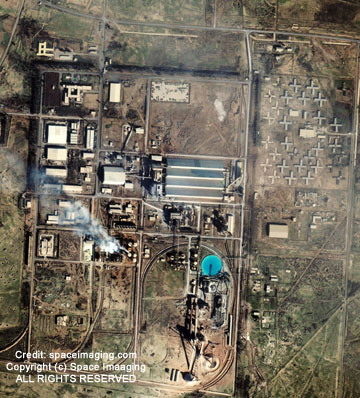


High-resolution commercial satellite imagery shows an apparently operational facility at the site of Iraq's al Qaim phosphate plant and uranium extraction facility (Unit-340), located in northwest Iraq near the Syrian border. This site was where Iraq extracted uranium for its nuclear weapons program in the 1980s. The al Qaim site was thoroughly destroyed by aerial bombing during the 1991 Persian Gulf War.
Given the absence of International Atomic Energy Agency (IAEA) Action Team inspectors on the ground since December 1998, however, this image raises questions about whether Iraq has rebuilt a uranium extraction facility at the site, possibly even underground. Iraq could have used parts salvaged from the bombed facility or new equipment bought illegally to reestablish this capability.
Unless inspectors go to the site and investigate all activities, the international community cannot exclude the possibility that Iraq is secretly producing a stockpile of uranium in violation of its commitments under Security Council resolutions. The uranium could be used in a clandestine nuclear weapons effort.
In January 1976, Iraq contracted with a Belgian company for the construction of a chemical fertilizer complex at al Qaim. By the second half of 1982, the unit for ore concentration at al Qaim was processing phosphate ore from the Akashat mine, located southwest of al Qaim.
In 1982, Iraq ordered the construction of a uranium extraction facility at the al Qaim site. The Belgian contractor, Mebshem, commissioned the facility at the end of 1984. Additionally, Mebshem trained Iraqi technical personnel to operate the uranium extraction unit.
The unit was designed to produce 54 tonnes of uranium peroxide(UO42H2O) per year-assuming continuous production of phosphoric acid at 150 m3/hr, and uranium content in the phosphate of 75 parts per million (ppm).
The uranium extraction facility at the al Qaim complex never reached maximum production. Through January 17, 1991, when Coalition forces bombed the facility, total production at the site was 170 tonnes of uranium peroxide, containing 110 tonnes of uranium. The relatively low output was due to: technical problems in the phosphoric acid unit; phosphate ore that yielded 40 ppm uranium as opposed to 75 ppm; technical problems in the piping connecting the phosphoric acid unit and the uranium production unit; technical problems with the rubber lining of the phosphoric acid tanks; and diversion of phosphoric acid directly to the fertilizer production unit rather than via the uranium unit.
The uranium that was produced at the unit was transferred directly to the secret nuclear weapons program in 11 separate shipments. Any unused uranium at the time the Action Team inspections started in 1991 was placed in a store at Tuwaitha. (For more information about and images of Tuwaitha, click here)